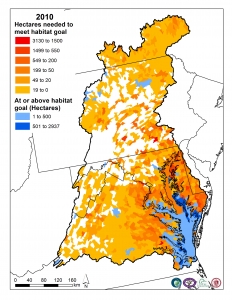The ACJV and partners (Black Duck Joint Venture [BDJV], Ducks Unlimited [DU] and University of Massachusetts) with funding from the Chesapeake Bay Trust recently completed a Decision Support Tool (DST) to help guide conservation efforts for Black Duck. The DST identifies watersheds that do not have enough food energy to support population goals of Black Duck as well as those areas that have surplus energy. This information allows land managers to assess the landscape and prioritize projects that best contribute to Black Duck population goals. We also believe the model can identify areas that should be prioritized for acquisition (i.e. where habitat quality and food resources are already high) or restoration (i.e. where food resources are low but could be restored).
In the Chesapeake Bay watershed, the model incorporates predicted changes in urban growth and sea-level rise at 2030 and 2080 to determine energy availability over time. We can use these predicted changes to inform our conservation decisions today based on the expected conditions of tomorrow. In this way, the DST will help partners to efficiently channel their conservation resources to the places that are expected to produce the greatest habitat benefit over the long term.
The ACJV is currently working with the North Atlantic Landscape Conservation Cooperative to host the Black Duck DST on the Regional Conservation Opportunity Areas online platform. This platform will allow land managers to access and map the model results of the DST in spatial form to inform their work. We hope to have the tool live by summer 2017























